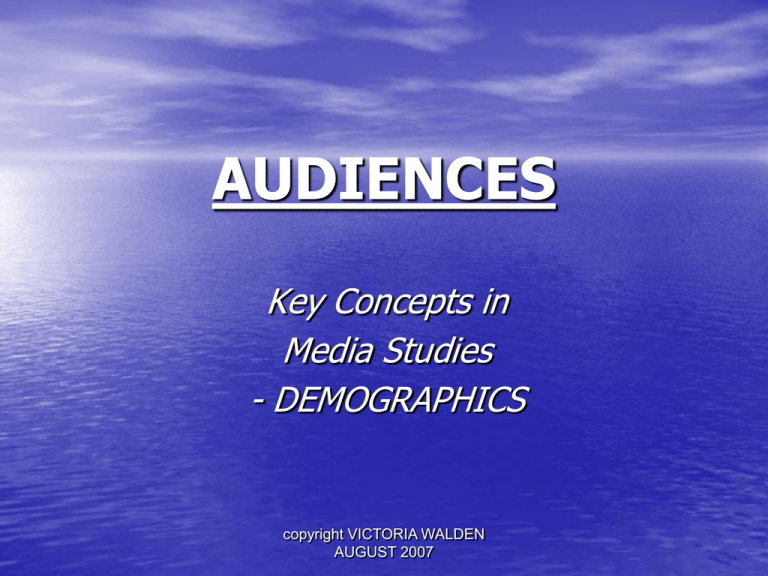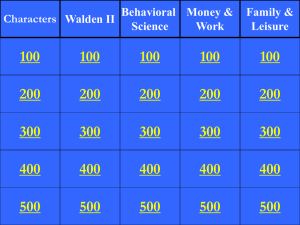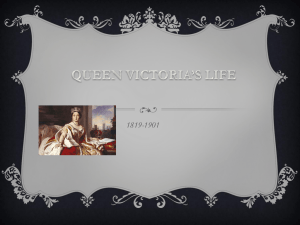Audiences Demographics updated
advertisement

AUDIENCES Key Concepts in Media Studies - DEMOGRAPHICS copyright VICTORIA WALDEN AUGUST 2007 MEDIA AUDIENCE …The CONSUMERS of mass media texts. Media audiences can be a group (cinema) or individual (reader). Consumption can take place in public or private and can be domestic, leisure or work related. copyright VICTORIA WALDEN AUGUST 2007 MEDIA TEXTS These include all things which can be “read” within the Media such as: Film Video Newspapers Magazines Mobile Technology/ Internet Radio Animation Advertising Photography Television copyright VICTORIA WALDEN AUGUST 2007 DEMOGRAPHICS Who watches/ reads what? • Demography is the study of human population. • Demographics include filtering or identifying people by: • RACE SEXUAL ORIENTATION • CLASS JOB • GENDER RELIGION • AGE DISABILITY copyright VICTORIA WALDEN AUGUST 2007 DEMOGRAPHICS The 5 Demographics we most commonly consider in Media are: • Class/ Income • Age • Gender • Interests/ Attitudes & Beliefs • Race copyright VICTORIA WALDEN AUGUST 2007 DEMOGRAPHICS RACE/ ETHNICITY- Country/ Cultural Origin i.e. African, Ethnic Minorities (within a culture), British, Asian etc… INTERESTS- i.e. fishing, sports, films- this helps in identifying WHO buys certain products/ watches certain programmes. For example, men that like film often like gadgets. Men that like cars quite often like football… AGE- We usually split into RANGES i.e. UNDER 16, 16-19, 19-25, 30-45, 45-60, OVER 60 copyright VICTORIA WALDEN AUGUST 2007 DEMOGRAPHICS GENDERWomen are the most sought after by TV advertisements. 60% 20-30 yr olds buying properties are Women. 70% of household purchases are done by Women. Men still make 64% of business decisions so are still targeted. Men are often split in to 2 intersecting segments: • Degree of success achieved. • Balance between “new” man and the more traditional “old” man. copyright VICTORIA WALDEN AUGUST 2007 DEMOGRAPHICS FAMILY LIFE CYCLES- SINGLES- Young single people living alone. NEWLY MARRIED COUPLES- young with no children. FULL NEST 1- young married couples with youngest child under 6. FULL NEST 2- young married couples with youngest child 6 or over. FULL NEST 3- Older married couples with dependent children. EMPTY NEST 1- Older married couples still in workforce, no children living with them. EMPTY NEST 2- Older married couples retired, no children living at home. SOLITARY SURVIVOR IN WORK PLACE. SOLITARY SURVIVOR, RETIRED. copyright VICTORIA WALDEN AUGUST 2007 DEMOGRAPHICS Youth MarketThe Youth Market is usually divided into “TRIBES” modern tribes include; • Punks • Trendies • Goths • Emo • Rock/ Metallers • “Chav” copyright VICTORIA WALDEN AUGUST 2007 DEMOGRAPHICS ATTITUDES & BELIEFSBELONGERS- Traditional, conservative conformists; family-orientated, like security, hate change and like a strong community EMULATORS-Young people searching for an identity, desiring to fit into adult world, but can be discouraged about prospects. EMULATOR-ACHIEVERS- Successful, enjoy acquiring things and buy brand names. SOCIETALLY CONSCIOUS ACHIEVERS- Inner peace and environment more important than financial success; want personal fulfilment, lovers of outdoors and fitness, like to experiment. NEEDS DIRECTED- Survivors on incomes that only allow needs and not wants to be fulfilled; pensioners and those on unemployment benefits, for example. copyright VICTORIA WALDEN AUGUST 2007 DEMOGRAPHICS "Maslow developed a model called the "Hierarchy of Needs”, which demonstrates that we must fulfil our basic needs (at the bottom) before progressing up to the next step and so on. Advertisers know this…there is no point advertising a flashy new car with GPS, blue lights, original design to someone who can barely afford to live. If they need to buy a car, they will want to know how it can get them from A-B to help http://www.futurehi.net/images/maslow.jpg them make a living. copyright VICTORIA WALDEN AUGUST 2007 EXERCISE • Can you identify yourself in one of the “youth” tribes and one of the specific attitudes and beliefs? • How do you think an advertiser could persuade you to buy a product? copyright VICTORIA WALDEN AUGUST 2007 DEMOGRAPHICS CLASS- We divide class into 5 categories: • A: Upper Middle Class: Higher managerial, administrative or professional • B: Middle Class: Intermediate managerial, administrative or professional • C1: Lower Middle Class: Supervisory or clerical and junior managerial, administrative or professional • C2: Skilled Working Class: Skilled manual workers • D: Working Class: Semi and unskilled manual workers • E: Lower Class: Unemployed, Homeless, Non-income http://www.businessballs.com/demographicsclassifications.htm EXERCISE How do PRODUCERS attract a particular audience? TASK Look at the following audience types and think about the different magazines/ newspapers/ TV programmes/ films they may watch. copyright VICTORIA WALDEN AUGUST 2007 EXERCISE 1. 2. 3. 4. 5. 6. White, British, Middle Aged, Upper Class Men interested in Politics and Golf. Young Male teenagers of ethnic descent living in London, interested in girls, having fun and spending time with their mates. Young Middle Class males, interested in film. Middle aged, Upper Middle or Upper class housewives with children, interested in family, shopping and gossip. Lower class, working woman with children interested in gossip and neighbourhood friendships. Lower class, working men interested in football and drinking with mates. MATCH (magazine) Kidulthood (Film) The Proms (TV) Queen’s Speech (TV) Evening Standard (Newspaper) The Sun (Newspaper) Take A Break (magazine) Spiderman (Film) Sense and Sensibility (Film) Coronation Street (TV) Neighbours (TV) Trinny and Suzanna (TV) Match of the Day (TV) Loose Women (TV) 2 Fast 2 Furious (Film) City of Lost Children (Fr) (Film) Empire (Magazine) Now look at this list of programmes/ magazines and newspapers- which ones would you match with each audience group. copyright VICTORIA WALDEN AUGUST 2007 EXERCISE • Now try and explain why you picked the different programmes/ newspapers and magazines for the different audiences. • Why is it important that Producers are aware of audience trends and what different people want to watch? copyright VICTORIA WALDEN AUGUST 2007 EXERCISE • Watch 4 films that seem to be aimed at the same audience demographic- what similarities do these films have with each other? • How did you first realise who the intended audience was? copyright VICTORIA WALDEN AUGUST 2007 ANSWERS Middle Aged, Upper Class Men interested in Politics and Golf. The Proms Queen’s Speech Evening Standard Young Male teenagers of ethnic descent living in London, interested in girls, having fun and spending time with their mates. MATCH (magazine) Kidulthood (Film) Young Middle Class males, interested in film. Empire (Magazine) City of Lost Children (Fr) (Film) 2 Fast 2 Furious (Film) Spiderman (Film) Middle aged, Upper Middle or Upper class housewives with children, interested in family, shopping and gossip. Loose Women (TV) Sense and Sensibility (Film) Lower class, working woman with children interested in gossip and neighbourhood friendships. Take A Break (magazine) Coronation Street (TV) Neighbours (TV) Trinny and Suzanna (TV) Lower class, working men interested in football and drinking with mates. The Sun (Newspaper) Match of the Day (TV) copyright VICTORIA WALDEN AUGUST 2007 DEMOGRAPHICS Something to think about…. What TV programmes/ Magazines/ Newspapers/ Films do you watch/read? Identify yourself in the demographics of societydo you think you are the “INTENDED” audience for what you watch/read? copyright VICTORIA WALDEN AUGUST 2007 Find out the demographic profile of three different magazines • http://megamediamarketing.net/demogra phics.html • http://www.bauermedia.co.uk/press/nrs • Google name of magazine + demographics / nrs Appeal to audience • Select one magazine • Identify its target demographic as closely as possible • Select one article within the magazine and identify exactly how it sets out to appeal to its audience copyright VICTORIA WALDEN AUGUST 2007 Homework for 5 October On a magazine of your own choice: • Explain the demographic profile of the magazine and the primary audience (average reader) • Select one article and explain in detail how it appeals to its primary audience • Discuss text, image and layout • Bring the magazine in next week, along with with the work copyright VICTORIA WALDEN AUGUST 2007







